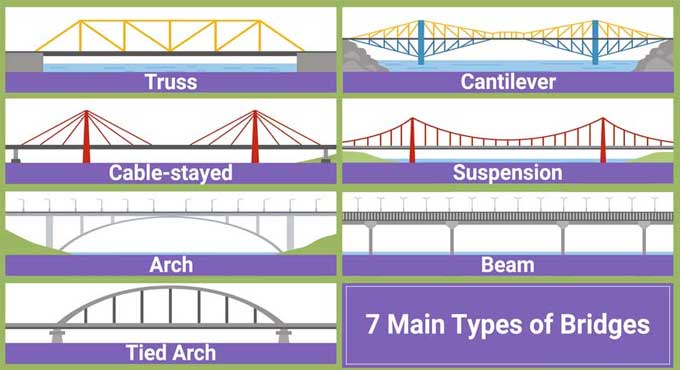
Bridge Types: An Explanatory Guide with Different Types
Developing bridges that are unique and safe for people begins with an understanding of bridges as a construction worker and civil engineer. For a bridge to carry a lot of vehicles year after year & decade after decade, you must calculate its daily vehicle load.
Arch Bridges
A classic bridge type, arch bridges are the oldest bridges after girder bridges in terms of architecture. Stone is well suited to arches as opposed to simple girder bridges. A typical arch does not require piers in the center, making it an attractive choice for crossing valleys and rivers. There are many types of bridges, but arch bridges can be one of the most beautiful.
Arches are built with curved structures that are highly resistant to bending. As opposed to girder and truss bridges, arch bridges are fixed horizontally on both ends, so they can only be used on solid ground. The arch bearings experience horizontal forces when a load is placed on the bridge. There are some cases in which the roadway passes over or through an arch, just as the truss does.
Rigid Frame Bridges
The girder and the piers of a standard girder bridge are separate structures. A rigid frame bridge, on the other hand, is an all-solid construction consisting of piers and girders.
Especially suited to rivers and valleys, batter post rigid frame bridges can be built using piers tilted at an angle to straddle the crossings more effectively without having to construct foundations in the river or piers in deep valleys.
I-Shaped
Bridge beams in rigid frames typically have I-shaped or box-shaped cross sections. Bridges with rigid frames are more difficult to design compared to bridges with girders. Precision and attention to detail are required when fabricating the junction between the pier and the girder.
V-Shaped
In spite of the fact that there are many possible frame shapes, pi-shaped frames, batter post frames, and V-shaped frames are almost exclusively used these days.
Foundations can be effectively utilized with V-shaped frames. As each V-shaped pier supports two girders, fewer foundations are required and a less cluttered profile is achieved.
As piers and supports for inner city highways, pi-shaped rigid frame structures are commonly used. Under these types of bridges, the frame supports the raised highway while also allowing traffic to run directly underneath.
Truss Bridges
A truss bridge is the most common type of bridge, usually made of steel. Many small beams make up a truss, which can support a large amount of weight and span long distances. Trusses are usually relatively simple to design, fabricate, and erect.
Nevertheless, once assembled, trusses take up a large amount of space and, in more complex structures, may cause drivers to become distracted. Both simple and continuous trusses are used for bridges with girders.
During an erection, large cranes and heavy equipment cannot be used due to the small size of individual parts of a truss. A hollow truss bridge often permits clearance below the bridge that would not be possible with other bridge types due to skeletal structure.
Three trusses are represented most often in the Warren truss, the Pratt truss, and the Howe truss.
Warren Truss
There are two types of Warren trusses: continuous trusses and simple trusses.
The structure looks simple since no vertical members are used for smaller spans. In addition to horizontal members, vertical members provide extra strength for longer spans. For spans between 50 and 100 meters, Warren trusses are commonly used.
Pratt Truss
Except for the very end diagonal members, the Pratt truss is identified by its slanting diagonal members. In general, diagonal members are stretched and compressed only by the shorter vertical members, except for those near the center. A thinner diagonal member is possible, resulting in a more economical design.
Howe Truss
Unlike Pratt trusses, Howe trusses have an X shaped cross section. A diagonal member bears the weight of compressive forces in the opposite direction. As a result, it is a very uneconomic design for steel bridges, and it is rarely used.
Girder Bridges
A girder bridge is the most common and simplest type of bridge. In its simplest form, a log crossing a creek is an example of a girder bridge. I-beam girders and box girders are the two most common types of girders in steel girder bridges. It is obvious from the cross section of the I-beam that it is so named. Flanges are the top and bottom plates, and the vertical plate in the middle is called the web.
Box girders have two webs and two flanges and take the shape of a box. There are sometimes more than two webs in a box girder, creating multiple chambers. Similarly-shaped girders such as pi girders, named for their resemblance to the mathematical symbol for pi, and T-shaped girders can also be considered simple girders. A girder bridge is typically formed by box or I-beam girders.
To get more details, watch the following video tutorial.
Video Source: WIRED
Cable Stayed Bridges
It consists of a continuous girder with an upper tower erected over two or more piers in the middle of the span. Cables extend diagonally down from these towers and support the girder. Strong and flexible steel cables have a high strength-to-weight ratio. In addition to being slender and lighter, cables are also capable of spanning large distances, which make them very economical.
It is true that only a few cables in total are strong enough to support the entire bridge. However, their flexibility makes them prone to damage due to forces you rarely consider, such as the wind & earthquake.


